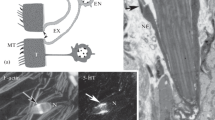Summary
The histochemical studies of the alarm substance cells from Phoxinus phoxinus and Morulius chrysophakedion (Cyprininae, Cyprinidae, Cypriniformes, Ostariophysi) are in total agreement with the results of the ultrastructural investigations. Perinuclear ribosomes, mitochondria, and a golgi complex are demonstrated. A tubular network radiates from the golgi complex. Histochemically, glycogen granula can occasionally be demonstrated in proximity to the nucleus. Consistently a strong RNA reaction as well as succinic-dehydrogenase activity, lactic-dehydrogenase activity, and in some cells glucose-6-phosphatedehydrogenase activity can be shown. In the cytoplasm of the alarm substance cell leucyl-aminopeptidase activity exists; its maximum lies in vicinity of the nucleus. Proteins and diastase-resistant polysaccharides are found only in cytoplasm not directly adjacent to the nucleus. The results indicate that the alarm substance cells show a secretory activity. It is assumed that the specific secrete is a protein of low molecular weight.
Zusammenfassung
Die Untersuchung der Histochemie und der Ultrastruktur der Schreckstoffzellen von Phoxinus phoxinus und Morulius chrysophakedion (Cyprininae, Cyprinidae, Cypriniformes, Ostariophysi) führte zu übereinstimmenden Ergebnissen. Unmittelbar perinucleär sind Ribosomen, Mitochondrien und ein Golgikomplex nachweisbar, von dem ein Netzwerk tubulärer Systeme ausgeht. Histochemisch sind in unmittelbarer Kernnähe gelegentlich Glykogengranula, stets ein deutlicher RNS-Gehalt und die Aktivitäten der Succinatdehydrogenase, der Lactatdehydrogenase, in einigen Zellen der Glucose-6-phosphat-dehydrogenase darstellbar. Im gesamten Cytoplasma der Schreckstoffzelle ist die Aktivität der Leucinaminopeptidase vorhanden, deren Maximum ebenfalls in Kernnähe vorliegt. Nur im kernfernen Cytoplasma wurden Proteine und diastaseresistente Polysaccharide nachgewiesen. Aus den Ergebnissen geht hervor, daß die Schreckstoffzellen sekretorisch tätig sind; vermutlich handelt es sich bei dem spezifischen Sekret um ein kleinmolekulares Protein.
Similar content being viewed by others
Literatur
Arnold, M.: Histochemie. Einführung in Grundlagen und Prinzipien der Methoden. Berlin-Heidelberg-New York: Springer 1968.
Frisch, K. v.: Zur Psychologie des Fischschwarms. Naturwissenschaften 26, 601–606 (1938).
—: Über einen Schreckstoff der Fischhaut und seine biologische Bedeutung. Z. vergl. Physiol. 29, 46–145 (1941).
Henrikson, R. C., Matoltsy, A. G.: The fine structure of teleost epidermis. III. Club cells and other cell types. J. Ultrastruct. Res. 21, 222–232 (1968).
Medeiros, L. O., Ferri, S., Godinho, H., Medeiros, L. F.: Proteins and polysaccharides of the club-shaped cells in the lining epithelium of fish (Pimelodus maculatus) digestive tract: histochemical study. Ann. Histochim. 15, 181–186 (1970).
Mittal, A. K., Munshi, J. S. D.: Histochemical and autoradiographic studies of skin glands of Rita rita (Ham.) (Bagridae, Pisces). Mikroskopie 24, 193–205 (1969).
Oxner, M.: Über die Kolbenzellen in der Epidermis der Fische, ihre Form, Verteilung, Entstehung und Bedeutung. Jena. Z. Naturwiss. 40, 589–646 (1905).
Pearse, A. G. E.: Histochemistry. Theoretical and applied. London: J. & A. Churchill Ltd. 1961.
Pfeiffer, W.: Über die Schreckreaktion bei Fischen und die Herkunft des Schreckstoffes. Z. vergl. Physiol. 43, 578–614 (1960).
—: The fright reaction of fish. Biol. Rev. 37, 495–511 (1962).
—: Vergleichende Untersuchungen über die Schreckreaktion und den Schreckstoff der Ostariophysen. Z. vergl. Physiol. 47, 111–147 (1963a).
—: Alarm substances. Experientia (Basel) 19, 113–123 (1963b).
Pfeiffer W.: Die Schreckreaktion der Fische und Kaulquappen. Naturwissenschaften 53, 565–570 (1966).
—: Schreckreaktion und Schreckstoffzellen bei Ostariophysi und Gonorhynchiformes. Z. vergl. Physiol. 56, 380–396 (1967).
—: Über die Schreckstoffzellen der Siluriformes (Ostariophysi, Pisces). Anat. Anz. 126, 113–119 (1970).
Romeis, B.: Mikroskopische Technik, 16. Aufl. München-Wien: Oldenbourg 1968.
Sasse, D., Pfeiffer, W., Arnold, M.: Epidermale Organe am Kopf von Morulius chrysophakedion (Cyprinidae, Ostariophysi, Pisces). Histochemische und elektronenmikroskopische Untersuchungen an den sog. „flaschenförmigen Organen“ von Labeo. Z. Zellforsch. 103, 218–231 (1970).
Schutz, F.: Vergleichende Untersuchungen über die Schreckreaktion bei Fischen und deren Verbreitung. Z. vergl. Physiol. 38, 84–135 (1956).
Author information
Authors and Affiliations
Additional information
Mit Unterstützung durch die Deutsche Forschungsgemeinschaft.
Rights and permissions
About this article
Cite this article
Pfeiffer, W., Sasse, D. & Arnold, M. Die Schreckstoffzellen von Phoxinus phoxinus und Morulius chrysophakedion (Cyprinidae, Ostariophysi, Pisces). Z. Zellforsch. 118, 203–213 (1971). https://doi.org/10.1007/BF00341564
Received:
Issue Date:
DOI: https://doi.org/10.1007/BF00341564




